






















the statements contained herein are believed to be correct, the publishers do not accept any liability or responsibility for inaccuracies or omissions. Reproduction of any part of this publication for

























the statements contained herein are believed to be correct, the publishers do not accept any liability or responsibility for inaccuracies or omissions. Reproduction of any part of this publication for

By Bruce Houlder CB KC, founder and trustee of FKCL (Charity number 1207588)
PLEASE NOTE: All design work produced by young students from Loughborough University in this edition is subject to copyright and may not be reproduced in any form without specific permission.
his 14th Edition of our magazine is a new departure in two ways. First it is written and to some extent designed by young people who have been inspired to contribute to the significant generational problems presented by knife crime, and its associated causes
Tin the UK. This edition also brings fresh perspectives from students of two of the leading universities concerned to work and research into community and youth empowerment in the UK - Sheffield Hallam University and Loughborough University.
The work they have been doing, showcased in this edition has much relevance to the work we do in London, and is more powerful because of the passion shown by the
students whose studies, and own life experience informs the contributions, and the design work ideas promoted in this edition. FKCL extends profound appreciation for what they have done. It is the product of a great deal of research, as well as their own perspectives as young people. So much of what they say will resonate with young Londoners and those working in youth empowerment.
Sheffield Hallam University’s law programme has a long history of pro-bono work and innovative clinical legal education. FKCL 1 has been working as formal partners with the University’s Institute of Law and Justice and the Helena Kennedy Centre of International Justice since its foundation ln 2021. Sheffield Hallam was one of the first Universities in the UK to establish a law clinic, and continues to lead the way with partnerships with international and UK firms providing professional collaborations which form the backbone of our pro-bono services.
Lisa Wooley is Senior Lecturer in Law Sheffield Hallam University Institute of Law & Justice Community Justice Hub Placement Supervisor, and she has been responsible for inspiring and coordinating this work not only for the students themselves who have been absolutely committed to this work, but also to support FKCL in spreading new thinking and research, and seeking to learn lessons from the experience of other regions of the United Kingdom.
This Hub provides an internal placement opportunity for Level 6 students in Law and Law & Criminology, and aims to work on those issues of
concern to the community and provide students with experience on social justice themes. In early December, FKCL’s founder Bruce Houlder chaired a Panel Event at the University, organised by the Community Justice Hub Placement students. The panel included Tracy Brown who has worked with young people in many different ways over a 25-year period, and Paul Hebda Youth and Integration Manager for Sheffield Wednesday Football Club’s Community Programme. The work of their Community Hub has also been promoted to the University’s external advisory committee as an exemplar of the work of the Institute.
STOP PRESS. This year students from Sheffield Hallam University’s Institute of Law & Justice’s Community Justice Hub have worked with FKCL to update and refresh FKCL critical directory of services. You will see these changes fully implemented in the next few weeks. If further changes are required by those included please do let us know.
Over the summer, outside of term time, Graphic Design students from Loughborough University were invited to take part in an elective project. They were invited to produce anti-knife crime campaign material to address the serious issue of knife crime and encourage positive societal change. Loughborough has been named for the fourth time by the Times as Sunday Times as the Sports University of the year and is a leader in community research and in seeking to improve living standards for everyone.
The coordinator of this project, produced in the students own free
time, is Helen Nowell . Helen teaches on the Graphic Design / Graphic Communication and Illustration Degree Courses at Loughborough University and is a Senior Fellow of the Higher Education Academy
The project brief asked students to tailor their campaigns to an audience of their choosing, each with a specific angle on addressing knife crime. They could choose to focus on convincing government officials to enforce stricter knife control laws or to reallocate funds to support community activities for young people in underprivileged areas. Students could target young individuals who might be vulnerable to the influence of knife crime or focus on informing parents of the risks that their children might face. They decided, and this is a selection of their inspiring work. We are particularly honoured to showcase some of their original designs shown throughout this 14 th Edition, and we invite you to explore their work further via the links in the contributions you will see. Helen Nowell’s article introduces the students, their work and how, in their own words, they were inspired to produce the designs you will see, as well as rehearsing some of the comments of the judges who assessed their work. Every one of them deserves our congratulations not only for their insights but also their thoughtful designs. They have assured careers!
We address an area we have not sufficiently covered before - The Online Safety Act 2023, but which cries out for closer attention. We are very pleased to have an article
from two experts in the field, Michael Railton, Senior Associate – Firearms, Knives and Weapons Lead and Cat Wharton MBE. Online Safety Policy Principal – Weapons, Drugs, Human Trafficking, and unlawful Immigration, both from the Online Safety Group ( www.ofcom.org.uk ).
A very Happy New Year to you all.
www.fightingknifecrime.london

References
[1] FKCL’s founder Bruce Houlder CB KC DL is the Chair of the Sheffield Hallam University ‘s Institute of Law and Justice Advisory Committee, and an Honorary Doctor of the University since 2015.
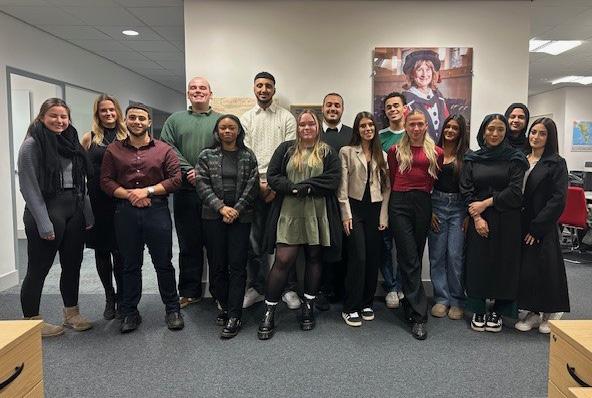
By Students of Sheffield Hallam University’s Institute of Law & Justice Community Justice Hub
The Community Justice Hub Team
Megan Lloyd, Beth Broadhead, Bilal Kassim, Alistair Jacques, Harlem Brown, Faizan Azam, Victoria (Toria) Stables, Zindin Berkouche, Destiny Barnes, Nathan Turner, Emily Kay, Anjali Mistry, Farjana (Masuma) Aktar, Malaika Ahmed, Aleena Akhtar
Sheffield Hallam University’s law programme has a long history of pro-bono work and innovative clinical legal education. FKCL has been working as formal partners with the University’s Institute of Law and Justice and the Helena Kennedy Centre of International Justice since our
foundation ln 2021. Sheffield Hallam was one of the first Universities in the UK to establish a law clinic, and continues to lead the way with partnerships with international and UK firms providing professional collaborations which form the backbone of our pro-bono services. Lisa Woolley is Senior Lecturer in Law Sheffield Hallam University’s, and the University’s Institute of Law & Justice Community Justice Hub Placement Supervisor. The Hub provides an internal placement opportunity for Level 6 students in Law and Law & Criminology and aims to work on those issues of concern to the community and provide students
with experience on social justice themes.
Lisa has been responsible for inspiring and coordinating this work not only for her committed students, but also to support FKCL in spreading new thinking and research and seeking to learn lessons not just within London but from the experience of other regions of the United Kingdom. FKCL’s ambition has always been to spread the work it seeks to do to other areas of England and Wales.
This year Sheffield Hallam University’s Institute of Law & Justice Community Justice Hub has worked closely with FKCL to check and update their critical directory of services, work to understand the challenges young people face, and how those issues impact young people in Sheffield, as well as in other regions. In early December, FKCL’s founder Bruce Houlder chaired a Panel Event at the University, organised by the Community Justice Hub Placement students. The panel included Tracy Brown who has worked with young people in many different ways over a 25 year period, and Paul Hebda Youth and Integration Manager for Sheffield Wednesday Football Club’s Community Programme. As part of their work this semester, and at the invitation of FKCL, the students researched into the issues and challenges within Sheffield and I am honoured to introduce their findings.
Introduction: economic inequality, food poverty, Industrial decline, child poverty, disadvantage and Cuts - and then glimpses of Hope.
Sheffield, a vibrant city with a rich industrial heritage, is also home to a diverse youth population. Like young people everywhere, Sheffield's youth face a unique set of challenges that
shape their experiences and aspirations. From economic inequality to mental health concerns, these issues have a profound impact on their lives.
This article will delve into some of the most pressing issues confronting the youth of Sheffield, exploring their causes, consequences, and potential solutions. By understanding these challenges, we can work together to create a more supportive and equitable environment for the next generation.

The Links Between Education and Poverty in Sheffield: (Beth Broadhead)
Sheffield continues to grapple with the challenges of post-industrial decline. This is particularly evident in the educational attainment of children living in poverty. Studies have revealed that only 47% of children eligible for free school meals in Sheffield are meeting the expected standards in the Early Years Foundation Stage. The situation is particularly dire in the north of the city, where neighbourhoods have high rates of deprivation. In Burngreave and Grimesthorpe, a staggering 68.5% of households are classified as deprived in at least one
dimension. Furthermore, Firth Park has a worrying 33% of residents over 16 with no qualifications, while Shirecliffe and Parkwood Springs have an alarming 46.8% of people aged 16 and over who are economically inactive. These statistics underscore the urgent need for targeted interventions to address the educational and economic disparities faced by Sheffield's disadvantaged communities. These areas of Sheffield are so severely deprived, and this can be seen through the amount of food banks servicing these areas. The S5 area specifically, which covers areas such as Firth Park, Fir Vale, Longley, Parson Cross, and Shirecliffe, has a shocking 7 food banks servicing the area, and these are just the registered charities. There are many more independent food banks that are servicing a specific area. Since April 2023, one of the more prominent food banks in Sheffield, the S6 foodbank, has been used by 68,937 people. 42,200 of these were adults and 26,737 were children. These areas of Sheffield that are more deprived tend to be out of ‘student’ areas. Sheffield has a huge student population that helps to boost the economy, particularly in the city centre. Areas around student housing, such as Eccesall, tend to be thriving economically compared to areas without students and outside of the city centre. Research has consistently demonstrated a strong connection between socioeconomic status and early childhood development. Children from low-income families, particularly those residing in impoverished neighbourhoods, often exhibit significant deficits in language and literacy skills. These deficiencies are frequently attributed to a variety of
factors, including limited access to educational resources, inadequate parental involvement, and exposure to environmental stressors. As a result of these challenges, children from disadvantaged backgrounds frequently lag behind their peers in academic achievement, often by as much as a year or more. In her research, Dr Emma Blakey, a developmental psychologist at the University of Sheffield, found that “ Poorer cognitive development may lead to struggling in school compared to more advantaged children who have had access to nutritional food and resources. ” A recent study by Action for Children has shed light on the alarming rise in child poverty within the Sheffield Heeley constituency. The report revealed that over 6,400 children were living in poverty between 2020 and 2021, representing a staggering increase of 36%, compared to the 7% rate recorded in 2014-2015. Furthermore, the data highlighted the significant impact of poverty on local education. More than 30% of children in the constituency are eligible for free school meals, indicating a high level of economic hardship. The report's findings underscore the urgent need for targeted interventions to address child poverty in Sheffield Heeley and ensure that all children have the opportunity to thrive. In speaking to community worker Tracy Brown , after the cuts to education and youth groups, a lot of communities didn’t survive. Only a few community organisations continued to give support. There were no statutory services, and it was down to the voluntary community sector to continue it. They provided opportunities for people to have different lives and experiences, and
have aspirations. The children that are seen to be causing the problem just get excluded and they then have free time and they have a higher chance of meeting predatory drug dealers and becoming victims of exploitation. The funding to youth groups being cut has been absolutely devastating. The community impacts that youth groups can have can be life-changing. Further in my interview with Tracy Brown she told us that there are some young people in prison, but some of the people that went to the youth group saw that they could do better than what home was providing. That glimpse of something else gave them hope. They were challenged and pushed not to settle, despite that being the easy option. When these groups are in place, they can help young people have a positive impact on the world.
[1] Louise Haigh, ‘True Extent of Child Poverty in Sheffield’ (Labour, 28 Feb 2023), https:// www.louisehaigh.org.uk/news/2023/02/28/ true-extent-of-child-poverty-revealed-in-sheffieldheeley/#:~:text=Here%20in%20Sheffield%20 Heeley%2C%20more,are%20from%20a%20 disadvantaged%20background
[2] KCL & Barnardo’s ‘I am concerned about young people’s mental health and that they have less hope for their future’ (June 2022), https://www.barnardos. org.uk/sites/default/files/uploads/KCL%20%26%20 Barnardo%27s%20QPS%20report.pdf
[3] Sheffield Food Banks, ‘Food Bank List’, http://www. sheffieldfoodbank.org.uk/food-bank-list/ Save The Children, ‘Sheffield Early Learning Community’ https://www.barnardos.org.uk/ sites/default/files/uploads/KCL%20%26%20 Barnardo%27s%20QPS%20report.pdf
[4] Samantha Hawkins, ‘Cost of Living: How Sheffield’s poverty scuppers children’s long term development’ (The Star, 19 May 2022), https://www.thestar.co.uk/ news/people/cost-of-living-how-sheffields-povertyscuppers-childrens-long-term-development-3700297

The start of a person’s life can affect how their life can unfold. As family is the first institution which shapes morals and values. The Social Justice Policy Group published a report in 2006 called Breakdown Britain which highlighted the impact that family breakdown has on crime and social justice. When children experience family breakdown, they are twice as likely to experience behavioural issues, have poor performance at school and can experience drug and alcohol problems in adulthood.
In 2023, there were 634 children in the care of the local authority. These were children who were placed in care, due to lack of familial support and at risk of being led into a criminal lifestyle. According to statistics, 33% of children who have been in care that were born between 1996 and 1999 received a caution or conviction before the age of 17. It was also found that when moved between two or more caregivers before the age of 10, boys are two times more likely to commit a violent crime. The Local Authority in Sheffield has adopted a new model which is based on supporting families and trying to keep children with their families. Sheffield has an “Early Help” service, which is dedicated to early intervention in families to help prevent
family displacement. If children do not feel supported at home, it’s possible that they will look to other sources outside of the home for support. This is how some children can be groomed into a criminal lifestyle. Greater family support from external services could help prevent children from needing to turn to crime.
[1]https://www.centreforsocialjustice.org.uk/wpcontent/uploads/2018/03/Breakdown-BritainCSJ.pdf
[2] Rogers, Bryan, Divorce and Separation: Outcomes for Children (first published 1998, Joseph Rowntree Foundation) 66
[3] HM Inspectorate of Probation ‘Family relationships’ (HM Inspectorate of Probation,10th March 2023) < https://www.justiceinspectorates. gov.uk/hmiprobation/research/the-evidence-baseyouth-offending-services/specific-areas-of-delivery/ family-relationships/#:~:text=divorce%20or%20 separation%20of%20parents,convicted%20of%20 a%20violent%20crime.> accessed 27 November 2024
[4] Ibid
[5] Sheffield City Council ‘Family Intervention Service’ (Sheffield City Council, 2024) < https://www. sheffielddirectory.org.uk/localoffer/about-the-localoffer-and-other-information/how-to-access-councileducation-and-social-care-services/family-interventionservice/>
(Emily Kay, Megan Lloyd, Nathan Turner)
There is a well-established connection between substance abuse and youth crime, particularly involving drugs and alcohol. Youth substance misuse statistics are currently at an alarming rate with 93% of those in substance facilities admitting they have a cannabis problem. Between April 2022 and March 2023, 12,418 people under the age of 18 were in contact with alcohol and drugs services. Young people may turn to substance abuse for numerous reasons, often shaped by psychological, social and
environmental factors. Social dynamics play a crucial role, as youths often face pressures of acceptance or rejection within their peer groups. Experimenting with drugs and alcohol may be perceived as a way to fit in or avoid exclusion. This risk is intensified by the easy access to substances, whether through family, peers, or local sources. Driven by ongoing brain development, the natural curiosity and risk-taking tendencies of young people make them more susceptible to experimentation. Young Minds1, a national mental health organisation states:
Over the longer-term, misusing drugs or alcohol can lead to serious mental health issues. Teenagers and young adults may be at greater risk of this because their brains are still developing. For example, some research shows that young people who use cannabis may be at greater risk of developing psychosis. Young people’s bodies are still developing physically, mentally and emotionally and the misuse of substances have lasting effects on the brain and the body. In Sheffield, there are organisations combating the significant rise in prevalence of substance abuse; one of these is The Corner which is specifically aimed at people under the age of 18. The Corner is part of Change, Grow, Live (a national health and social care charity). Substance abuse can also have subsequent consequences on education; attendance rates and grades dropping are just a few examples of how these habits can impact youth education.
The increasing currency of stress, anxiety and depression among young people also encourages substance abuse. Many use drugs or alcohol as a coping mechanism to escape emotional pain or manage personal struggles temporarily. This type of reliance on
substances as a form of self-medication can rapidly spiral into heavy dependency and addiction.
Unstable home environments can further exacerbate issues. Domestic abuse, neglect, or parental substance abuse often normalise harmful behaviours, increasing the likelihood of young people being exposed to such conditions will follow similar patterns. For many, substance abuse becomes a reaction to misfortune.
There is a 10% increase in substance misuse in young people from the
previous year at 11,326, but a 13% reduction in treatment since 20192020 at 14,291. Cannabis is the most common substance at 87% of young people receiving treatment, with 44% of young people who said they had problems with alcohol, 7% with ecstasy, and 9% with powder cocaine, as well as this, 2% have problems with benzodiazepines (Xanax, Valium), 5.1% have problems with solvent abuse, and 5.8% have problems with ketamine.
The challenges that face young adults today are further exacerbated by a lack of education and awareness regarding the dangers of drugs and alcohol. Young people don’t often understand the long-term consequences of substance abuse, leaving them ill-equipped to make well informed decisions. Without proper guidance and education, the risks of experimentation and curiosity can escalate into chronic misuse, which in turn can leave our young people exposed to a life of criminal activity.
Sheffield operates a needle exchange programme which allows injecting drug users to receive clean injecting equipment and return used equipment which can be disposed of safely. Offering a needle exchange programme is recognised as an effective method to reduce harm.
Youth substance misuse statistics are currently at an alarming rate with 93% of those in substance facilities stating they have a cannabis problem. Between April 2022 and March 2023, 12,418 youths (under 18s) were in contact with alcohol and drugs services. These numbers have a massive impact on the lives of many children and families. Young Minds, a national mental health organisation states:
“Over the longer-term, misusing drugs or alcohol can lead to serious mental health issues. Teenagers and young adults may be at greater risk of this because their brains are still developing. For example, some research shows that young people who use cannabis may be at greater risk of developing psychosis.”
[1] https://www.youngminds.org.uk
[2] The Talk About Trust, ‘10% rise in number of under 18’s being treated for alcohol or drugs –cannabis remains the key problem’ (The Talk About Trust, 10 January 2024) < https://talkabouttrust. org/news/10-rise-in-number-of-under-18sbeing-treated-for-alcohol-or-drugs-cannabisremains-the-key-problem-2/> accessed 16 October 2024.
[3] Gov UK, ‘Young people’s substance misuse treatment statistics 2022 to 2023: report’ (Gov UK, 25 January 2024) <https://www.gov.uk/ government/statistics/substance-misusetreatment-for-young-people-2022-to-2023/ young-peoples-substance-misuse-treatmentstatistics-2022-to-2023-report#:~:text=the%20 previous%20year.-,Age%20and%20 sex%20of%20young%20people%20in%20 treatment,for%20girls%20and%20for%20boys.> accessed 16 October 2024.
[4] ‘Young People’s Substance Misuse Treatment Statistics 2022 to 2023: Report’ (GOV.UK, 25 January 2024) <https://www.gov.uk/government/ statistics/substance-misuse-treatment-foryoung-people-2022-to-2023/young-peoplessubstance-misuse-treatment-statistics-2022-to2023-report#:~:text=Around%20half%20of%20 young%20people,to%200.8%25%20this%20 year).> accessed 23 October 2024
[5] Young Minds, ‘Drugs and alcohol’ (Young Minds) <https://www.youngminds.org.uk/ parent/parents-a-z-mental-health-guide/ drugs-and-alcohol/#:~:text=Over%20the%20 longer%2Dterm%2C%20misusing,greater%20 risk%20of%20developing%20psychosis.> accessed 16 October 2024.
[6] Help Us Help, Drug & Alcohol Services, <Help us Help Drugs and alcohol support> Accessed on 20th October 2024.
[7] Sheffield Drugs and Alcohol Coordination Team, Statistics, <Statistics | Sheffield Drugs and Alcohol> Accessed on 20th October 2024.
[8] Sheffield City Council, Drugs and Alcohol Support, <Drugs and alcohol support | Sheffield City Council> Accessed on 20th October 2024.
What impact does knife crime have on Sheffield Youths?
(Masuma Aktar, Toria Stables, Anjali Mistry)
What happens to young people when carrying a knife becomes as common as carrying a smartphone? This haunting question reflects the grim reality unfolding in parts of the UK, such as South Yorkshire. In Sheffield, children as young as eight have reported using knives to make threats, with knife-related incidents involving youth accounting for 10% of local offences. This disturbing trend demands urgent action.
Sheffield has seen a steady rise in knife crime, with an overall crime rate of 91 offences per 1,000 people in 2021. Knives or daggers are the most common weapons in violent crimes (42%), followed by kitchen knives (19%) and other implements like Stanley knives, glass bottles, and machetes. Police have had to respond to multiple stabbing incidents over the past year, underscoring the severity of the issue:
• A 29-year-old man was stabbed near Park Grange Road in an unprovoked attack.
• A 17-year-old boy suffered life-threatening injuries in an altercation at St. Mary’s Gate.
• A 21-year-old man was wounded during a group fight on Staniforth Road.
Knife crime leaves more than physical wounds—it instils fear among residents. Parents express their anxiety about their children's safety, torn between allowing independence and protecting them from harm. One local parent shared, ‘I fear for my boy, but I daren’t [sic] give him any freedom because of the ‘what ifs.’
On the positive side, Sheffield’s community has rallied to tackle the root causes of knife crime. Several organisations are working to protect vulnerable youth and create safer communities:
SYJS is a government body that partners with Community Youth Teams (CYTs)1 to support young people aged 10–18. Their mission is to guide at-risk youth away from crime, focusing on education, training, and employment. One flagship initiative is the ‘No Point’ program, designed to educate young people about the dangers of carrying knives. The program seeks to dismantle the false sense of security knife carriers often feel, highlight the legal consequences of knife-related crimes, and promote positive decision-making.
Community Youth Teams (CYTs) operates citywide. They collaborate with schools, statutory bodies, and voluntary organisations to support young people in vulnerable situations. Their approach emphasises:
• Empowering young people through education and mentorship.
• Promoting healthy choices and reducing risky behaviours.
• Equipping youth with tools to avoid exploitation, gang involvement, and harmful environment
This volunteer-driven non-profit campaign group aims to reduce knife crime through education, awareness, and direct action. Their efforts include a free knife and weapon collection service, enabling individuals to safely dispose of dangerous items in accordance with police guidelines.
Keep Sheffield Stainless also provides a supportive space for those affected by knife violence, fostering community solidarity. The group’s mission2 is simple yet powerful: reduce knife-related injuries and deaths by inspiring collective action.
Sheffield's efforts are strengthened by the Crime and Disorder Act 1998, which established Community Safety Partnerships (CSPs). This Act has had a significant impact on youths as it introduced a new unified system for youth justice differing from the adult justice system. These partnerships, like the Safer Sheffield Partnership, unite local authorities, police, fire services, and health organisations to create strategies for reducing crime. Additionally, Section 45 of the Youth Justice and Criminal Evidence Act 1999 ensures the identities of young offenders remain protected in legal proceedings, balancing accountability with safeguarding.
The challenges are immense, and nationwide, but Sheffield’s determination to combat knife crime is evident. However, residents highlight systemic issues that exacerbate the problem:
• The national decline of youth clubs and recreational services has left many young people with limited positive outlets.
• Expulsions to Pupil Referral Units (PRUs) leave students unsupervised and susceptible to exploitation.
• Economic and social inequality creates a sense of hopelessness for some children, trapping them in cycles of crime.
Addressing these issues requires sustained effort and investment in youth
services, education, and community support. Organisations like SYJS and Keep Sheffield Stainless offer a blueprint for meaningful change, but they need widespread backing to succeed.
The human cost of knife crime is devastating. Richard Dentith, a 31-yearold father, was fatally stabbed by a 16-year-old in 2022. Naming his teenage killer, Yaqeen Arshad, marked a pivotal moment in raising awareness about the consequences of youth violence. Stories like these are a stark reminder of the urgent need for action.
Sheffield’s fight against knife crime is a battle for its future. The city’s young people deserve safety, opportunity, and hope—and through collaboration, education, and community-driven solutions and this is what Sheffield aims to deliver.
[1] http://www.sheffield-yos.org.uk/resourcesprogrammes/lsquono-pointrsquo-knife-crime-programme/, https://www.sheffield.gov.uk/social-care/children/cyt [2] https://alwaysanalternative.org.uk
[1] https://www.sheffield-yos.org.uk/resources-programmes/ lsquono-pointrsquo-knife-crime-programme/
[2] https://www.holdthefrontpage.co.uk/2023/news/ daily-wins-court-fight-to-name-teen-killer-in-bid-tostop-knife-crime/ https://www.sheffield-yos.org.uk/community-youthteams/community-youth-teams/
[3] committees. parliament.uk, ‘Written evidence from the Magistrate Association’. https://committees.parliament.uk/writtenevidence/105447/html/ [4] https://alwaysanalternative.org.uk/ knife-crime-statistics-sheffield-southyorkshire/#:~:text=Children%2FUnder%20 18%20Statistics,offences%20from%20 possession%20to%20murder.&text=A%20random%20dip%20sample%20of,to%20 make%20threats%20in%20schools.
[5] https://committees.parliament.uk/ writtenevidence/105447/html/


Austerity: betraying Britain's youth (Alistair Jacques, Faizan Azam and Bilal Kassim)
There seems to be an air of hopelessness for young people today, with 59% of 16-25-year-olds agreeing the future is ‘frightening’ for our generation and 45% saying anxiety around recent political and economic events impacts them daily1. If viewed with recency bias, we could solely blame the COVID-19 outbreak or the wars around the world- and while these events have been pertinent in creating this damaged collective psyche, there is a missing key factor in the common narrative. It is the same factor that has closed down youth clubs and killed 190,000 People through ‘excess deaths’2; This factor is ‘austerity'.
The youth of Britain are experiencing multiple crises at once, ranging from a mental health epidemic3, compounded by an underfunded NHS,4 to massive rates of youth unemployment5. However, these are not unrelated issues, but a symptom of the larger one of where and by whom funding is allocated, with no regard for those left behind.
Austerity refers to a set of policies in which, to reduce the budget deficit (the amount of spending that exceeds income), government spending is
drastically cut. Following the Global financial crisis 6 the coalition government in 2010 implemented a series of austerity policies in an attempt to both fix the economy and satisfy the anger towards the establishment following the crash. The framing of these cuts was that they were an economic necessity, with no alternative options. This was rationalised using the disastrous Greek debt crisis as a cautionary tale7 for the British government to steer clear of. However, opinions among academics differ on this.
In the article ‘Austerity: The World's Mistake in their Recovery from 2008’8 economist, Micheal Huang outlines the function of government spending after a recession. He states Government expenditure is essential for boosting the economy, particularly in times of recession. When the economy is ailing, austerity, which reduces government spending, diminishes this boost. For instance, when the government imposed austerity measures in 2010 while the economy was still rebounding, the UK experienced protracted economic stagnation. This resulted in poor growth and high unemployment, proving that austerity worsened the issues it intended to address.
Austerity is frequently viewed as required at specific stages of the economic cycle, especially when the public debt is unmanageable or the economy is expanding quickly. Reducing government deficits and preventing financial instability are the main goals of austerity, particularly after a debt crisis. As an illustration of the dangers of unrestrained borrowing, Greece's sovereign debt crisis in 2015 saw the country's debt-to-GDP ratio grow from 28% to 175.9% over three decades9. In these situations, austerity measures like
higher taxes or spending cuts are seen as a way to guarantee sustainable growth, lower borrowing costs, and restore fiscal credibility. Austerity, according to its supporters, is required to preserve public trust in the government's finances and avoid a debt spiral similar to that which occurred in Greece.
The issues caused by austerity were not just affecting services directly used by children themselves, but those that helped families raise their children. Sure Start Children’s centres allowed a onestop shop for parents- directly preventing 13,000 hospitalisations of children ages 11-1510, using preventative healthcare to leave capacity within the NHS. According to the report ‘Sure Start, Uncertain Future’11 by UNISON more than 38% of council children’s centres have been closed across England since 2010. Lowered funding in local authorities shut down 68% of centres in the South East and 59% in the West Midlands between 2010/11 and 2022/23.
These centres had a significant impact and a range of support that focused on improving the lives of families. They offered support for families with children aged up to five and high-quality play, learning and childcare experiences for children. Closures have resulted in continuous losses of key community services such as health visitors, speech and language development experts, healthy eating programmes, parenting classes, school readiness sessions and other types of family support. Additionally, closures have disproportionately impacted children from disadvantaged backgrounds, with an IFS study finding that the centres significantly improved educational outcomes up to the GCSE level12 - this ended when the centres did and as a
result, children and families were left to fend for themselves.


Figure 1: The distribution of austerity shocks across local authority districts in the United Kingdom.13
Over the past decade, the UK has witnessed the systematic dismantling of its youth services. Funding for youth services has been slashed by 73%, amounting to a staggering £1 billion in real-terms cuts. These closures have not only deprived young people of safe spaces to socialise and access support but have also had significant ripple effects on education, crime, and broader societal outcomes14.

Youth clubs have long been integral to supporting young people’s academic journeys. Beyond offering recreational opportunities, they provide mentorship and stability that complement formal education. Research by the Institute for Fiscal Studies (IFS) underscores this connection, showing a clear correlation between youth club closures and declining GCSE results.15 In areas most affected by these closures, the absence of structured support has left many young people struggling to achieve their potential, highlighting the critical role youth services play in fostering both social and academic development.
The link between the decline in youth services and rising youth crime is equally stark. With fewer safe and structured environments available, many young people are turning to unproductive or risky behaviours. Estimates suggest that every £1 saved by austerity-driven cuts results in £2.85 in public and private losses, primarily due to increased crime and its associated costs.16 This trend is particularly pronounced in marginalised communities, where alternative resources are scarce, deepening existing inequalities and social challenges.
Adding to the crisis is the sharp decline in trained youth workers. As universities have discontinued courses in youth work, services have been left understaffed or reliant on untrained volunteers.17 This lack of expertise has further diminished the effectiveness of the remaining youth services, compounding the challenges faced by young people. Without professional support, the quality and reach of youth provision have been severely compromised.
The closures of youth clubs starkly illustrate the unintended consequences of austerity measures. While aimed at reducing costs, these cuts have created long-term societal issues, from declining educational outcomes18 to rising crime rates.19 Marginalised communities are bearing the brunt of these decisions, with young people facing a future of reduced opportunities and increased vulnerability.
These issues are not an isolated phenomena. They are the results of a set of economic rules imposed upon the youth of this country. These rules were established out of a crisis we had no hand in creating, and were falsely presented as the only option. Reversing these trends requires a renewed commitment to youth services and a prioritisation of young people’s quality of life rather than arbitrary targets. flat increases in funding will not result in the change we needthat will only happen when policymakers recognise the value of investing in everyday working people, acknowledging the long-term benefits that arise from investing in your population from a young age. By taking on this more holistic approach, institutions can address the root causes of the challenges facing our youth, creating safer, more equitable communities and safeguarding the potential of future generations.
[1] Rebecca Speare-Cole, 'Almost 60% of young people are fearful for their generation’s future , study finds' (The Independent, Monday 03 October) https://www.independent.co.uk/life-style/ young-adults-anxiety-stress-futureuk-b2191457.html#:~:text=Almost%20 two%20thirds%20of%20young%20people%20 in%20the,59%25%20agree%20it%20is%20 %E2%80%9Cfrightening%E2%80%9D%20for%20 their%20generation
[2] Yonatan Berman, Tora Hovland, 'The cost of austerity: How UK public spending cuts led to 190,000 excess deaths' (LSE, June 19th) https://blogs.lse.ac.uk/inequalities/2024/06/19/ the-cost-of-austerity-how-spending-cuts-led-to190000-excess-deaths/
[3] NHS England, 'One in five children and young people had a probable mental disorder in 2023' (NHS England Website, 21 November 2023) https://www. england.nhs.uk/2023/11/one-in-five-children-and-youngpeople-had-a-probable-mental-disorder-in-2023
[4] Adam Roberts and others, 'A decade of austerity? The funding pressures facing the NHS from 2010/11 to 2021/22' [2012] Nuffield trust https://www.nuffieldtrust.org.uk/research/adecade-of-austerity-the-funding-pressures-facingthe-nhs-from-2010-11-to-2021-22
[5] Amy Borrett, 'Why are a rising number of young Britons out of work https://www.ft.com/content/4b5d3da2-e8f4-4d1ca53a-97bb8e9b1439?accessToken=zwAAAZPkLWm Dkc9LXT2i6PRNHNOlOpe7jpsUOQ.MEUCIQDHW qFKimeIdeqyyndAVaKrNGmQKKCWdWxv1NeY1Q 4rZQIgXtp3unYmewi5uqC0q7vfQWZ0S9t39Bic2ft gpEbqsYI&segmentId=e95a9ae7-622c-6235-5f8751e412b47e97&shareType=enterprise&shareId=64 2ecaf0-18ec-476c-a55f-42011c07ab99
[6] Bank of England, 'The financial crisis- 10 years on' (Bank of England website) https://www. bankofengland.co.uk/news/2018/september/thefinancial-crisis-ten-years-on
[7] LSE, 'Austerity in the UK: past, present and future' (LSE Website, 11 march 2015) https:// blogs.lse.ac.uk/politicsandpolicy/austerity-pastpresent-and-future/
[8] The Perceiver, 'Austerity: The world's mistake in their recovery from 2008' (The Perceiver, May 31st) https://www.theperceiver.org/post/austerity-theworld-s-mistake-in-their-recovery-from-2008
[9] Trading economics, 'Greece government to debt GDP (Trading economics website)
https://tradingeconomics.com/greece/governmentdebt-to-gdp
[10] Nuffield foundation, 'At their peak, Sure Start centresprevented13,000hospitalisationsayearamong 11-to15-year-olds'(Nuffieldfoundationwebsite,16th august)https://www.nuffieldfoundation.org/news/sure-startcentres-reduced-hospitalisations#:%7E:text=Children%20 who%20had%20greater%20access%20to%20Sure%20 Start,long-lasting%20for%20boys%20and%20children%20 in%20disadvantaged%20neighbourhoods.%E2%80%9D Nuffieldfoundation,'Attheirpeak,SureStartcentres prevented13,000hospitalisationsayearamong11-to 15-year-olds'(Nuffieldfoundationwebsite,16thaugust) https://www.nuffieldfoundation.org/news/sure-start-centresreduced-hospitalisations#:%7E:text=Children%20who%20 had%20greater%20access%20to%20Sure%20Start,longlasting%20for%20boys%20and%20children%20in%20 disadvantaged%20neighbourhoods.%E2%80%9D
[11] Unison, 'Sure start, uncertain future' (UNISON website, June) https://www.unison.org.uk/content/ uploads/2024/06/Childrens-centres-report-final.pdf
[12] Institute for fiscal studies, 'The short- and medium-term impacts of Sure Start on educational outcomes' (IFS Report R307, 9th April) https://ifs.org. uk/publications/short-and-medium-term-impactssure-start-educational-outcomes
[13] Yonatan Berman, 'The Impact of Austerity on Mortality and Life Expectancy' [2024] The Impact of Austerity on Mortality and Life Expectancy https:// eprints.lse.ac.uk/123915/1/WP_139.pdf
[14] Institute for Fiscal Studies, The Decline of Youth Services and the Impact on Education and Crime (IFS, 2021) https://www.ifs.org.uk/publications/15291
[15] UNISON, Freedom of Information Report: Youth Service Cuts (UNISON, June 2024) https://www. unison.org.uk/content/uploads/2024/06/youthservices-final-FINAL.pdf
[16] UNISON, Freedom of Information Report: Youth Service Cuts (UNISON, April 2023) https://www. unison.org.uk/news/press-release/2023/04/youthservice-cuts-freedom-of-information-report/
[17] YMCA, Out of Service: A Report on the Decline of Youth Services in the UK (YMCA, 2023) https:// www.ymca.org.uk/latest-news/out-of-service
[18] UNISON, Freedom of Information Report: Youth Service Cuts (UNISON, April 2023) https://www. unison.org.uk/news/press-release/2023/04/youthservice-cuts-freedom-of-information-report/
[19] YMCA, Out of Service: A Report on the Decline of Youth Services in the UK (YMCA, 2023) https://files.localgov.co.uk/ymca.pdf

How does the exposure and influence of social media impact youths?
(Destiny Barnes)
As young people increasingly spending a significant proportion of their time online, understanding social media in both positive and negative aspects is crucial regarding promoting youth justice and protecting wellbeing. Research conducted by Action for Children reveals that over half of 5–15-year-olds use social media, with numbers almost reaching 90% for 12–15-year-olds.1 As such, social media is largely integrated into young people’s daily lives. Although positive in its ability for connection, engagement, and selfexpression, the negative impact on youths’ behaviour and on their decisionmaking is deeply concerning. Social media often glorifies illegal or risky behaviour, normalising specific trends of violence, crime and substance abuse, whilst desensitising impressionable youth to other real-life issues. It is of paramount importance to consider social media as both a tool for growth but also a catalyst for harm when considering the challenges young people face.
Social media influences youth offending behaviour, as young people can imitate
behaviours and interactions they have observed online. Published last November by Crest and the Youth Endowment Fund, a national youth survey of over 2,000 young people focusing on violence and vulnerability, found that in a 12-month period, 55 per cent of those surveyed had witnessed violence on social media, and 65 per cent had changed their behaviour to keep themselves safe from violence.2 Disadvantaged individuals particularly become vulnerable, as they may use social media as a coping mechanism where the spread of misinformation online can often facilitate harmful attitudes. Not only this but the promotion of unattainable beauty standards, the viral nature of dangerous challenges, and exposure to explicit content has the potential to leave deep psychological scars. Research shows that young people who spend significant time on platforms such as Instagram or TikTok are more likely to experience anxiety, depression, and distorted self-perception.30 Mental health issues are to be recognised as additional substantial concerns regarding cyberbullying and the extent of this issue. Marano Janin and Esther Ghey are both individuals who tragically have lost children, with social media-related influences. In respect to this, they are urging national changes to the way social media should be managed. Afterall social media is an overpowering mechanism worldwide that needs careful consideration of measures to ensure it remains a benefit rather than burden. Promoting responsible social media use, educating on online safety, and monitoring the impact of social media on behaviour can play a key role in preventing young people from entering the justice system and essentially keep them safe. Young Minds are a mental health charity for children, young people and their parents. In collaboration with the phone
company O2, they have come together to provide tips and advice on how social media might be developed to have a more positive effect. If you ever feel overwhelmed by the online world, unable to switch off, or find it difficult to cope, you are not alone and mechanisms like this recognise that.
Paul Hebda, a youth worker working with the Sheffield Wednesday FC Community Programme, highlighted that within his field of work, upcoming trends such as the prominence of social media has had an influence on young people. There are other activities which look like they too could become trends, such as, vaping together with a perceived arrogance in the attitude of youths towards the police. Young people are viewing the police as impotent to act against any misbehaviour by those young people. Tracy Brown also picked up on how as a generation growing up on the internet is increasingly encouraging us to not think for ourselves, but to let social media and technology encourage our thinking. Additionally, this is becoming a major youth issue, with such media sites aspect like ‘only fans and the way individuals are being encouraged to talk about sexual perceptions in a negative light due to sites such as ‘Pornhub ’.
In conclusion the influence of social media on young people does present a complex contradiction, acting as both a conduit for growth and trigger for harm. In places such as Australia, new legalisation has been introduced banning children under 16 from using social media.4 This reflects the growing recognition of these challenges and the need for proactive measures to be done moving forward. Initiatives that educate young people and their families about the potential dangers, while equipping them with tools to navigate the digital world, are essential to ensuring social media becomes a positive force
rather than a detriment. After all, who knows what’s next moving forward?
[1] Action For Children, ‘Social media and mental health: the good, the bad and the ugly’ (Blog, 29th December 2021) <https://www.actionforchildren.org.uk/blog/ social-media-and-mental-health-the-good-the-badand-the-ugly/> accessed 27th November 2024.
[2] Violette Gadenne & Patrick Olajide, ‘Under the influence: how harmful is social media to children and young people’ (Crestadvisory.com, 15th June 2023) <https://www.crestadvisory.com/post/under-theinfluence-how-harmful-is-social media#:~:text=It%20 involved%20a%20national%20youth,keep%20 themselves%20safe%20from%20violence> accessed 27th November 2024.
[3] Depression and Bipolar Support Alliance, ‘The Alliance Insider- TikTok and Youth Mental Health’ (TikTok and Youth Mental Health: Weighing the Pros and Cons) https://www. dbsalliance.org/education/newsletters/tiktok-and-youthmental-health/ accessed 11th December 2024.
[4] Hannah Ritchie, ‘Australia approves social media ban on under-16s’ (BBC News, 28th November 2024) < https:// www.bbc.co.uk/news/articles/c89vjj0lxx9o> accessed 11th December 2024.
[1] Hannah Ritchie, ‘Australia approves social media ban on under-16s’ (BBC News, 28th November 2024) < https:// www.bbc.co.uk/news/articles/c89vjj0lxx9o> accessed 11th December 2024.
[2] Action For Children, ‘Social media and mental health: the good, the bad and the ugly’ (Blog, 29th December 2021) <https://www.actionforchildren.org.uk/blog/social-media-andmental-health-the-good-the-bad-and-the-ugly/>
[3] Depression and Bipolar Support Alliance, ‘The Alliance Insider- TikTok and Youth Mental Health’ (TikTok and Youth Mental Health: Weighing the Pros and Cons) https://www.dbsalliance.org/education/newsletters/tiktokand-youth-mental-health
[4] Laura Kuenssberg & Sean Seddon ‘Mia Janin: Father wants cyber-bullying law after daughter’s death’ (BBC News, 2 March 2025) <https://www.bbc.co.uk/news/uk68456057> a Violette Gadenne & Patrick Olajide, ‘Under the influence: how harmful is social media to children and young people’ (Crestadvisory.com, 15th June 2023) <https:// www.crestadvisory.com/post/under-the-influence-howharmful-is-social-media#:~:text=It%20involved%20a%20 national%20youth,keep%20themselves%20safe%20 from%20violence>
[5] YOUNGMINDS, ‘Social Media and Mental Health’ (youngminds.org) <https://www.youngminds.org.uk/youngperson/coping-with-life/social-media-and-mental-health/>
in the Loop: Understanding Youth Recidivism in the UK (Zindin Bekhouche)
The highest reoffending rate by age was 35.4%1 for 10–14-year-olds, closely followed by 15-17-year-olds with 33.9%. Recidivism is defined as the act of continuing to commit crimes even after having been punished2. Why do we struggle to break this cycle, and what could this mean for the future of youth justice? This has continued to be a prevalent and progressive issue and, in this article, we will delve into the factors that influence this.
There has been a drastic decrease in funding for youth services, dropping by 63% between 2011-12 and 202122, from £947 million to £341 million3 These austerity-related cuts had a direct impact on youth offending rates. Young people who lost access to a youth club were 14% more likely to engage in criminal activity in the six years following closure 4. The same study also found that London youths who lost access to a nearby youth club performed nearly 4% of a standard deviation worse in their GCSE exams. These statistics indicate a clear link between youth services and youth integration into society.
Further research suggests that teenagers who receive below-average GCSE grades go on to earn less in their lifetime 5. This cycle of poor academic performance and subsequent lower lifetime income could lead to feelings of hopelessness and disengagement from society. This could in turn contribute to such an individual engaging in criminal activity. A study in London found that
40% more crimes were committed in the most income-deprived areas, with crimes such as violence, robbery, sexual offences and drugs & weapons offenses being more than 2x more prevalent 6. These findings highlight a long-standing battle between young people and the burden of their circumstances.

It’s vital also to consider the ethnic disproportionality in the youth justice system. The causes are complex and multifaceted; relevant factors include social deprivation, educational underachievement and exclusion, and family formation and functioning, combined with biases, labelling, and stigmatization 7 . For example, in the last five years, the proportion of stop and searches conducted on white suspects decreased (from 75% in 2014/15 to 59% in 2018/19), whilst the numbers increased from 13% to 22% for black suspects 8. This clearly demonstrates how protected groups can experience intersectionality within the justice system.
Approximately 19% of Sheffield's population is BAME, but Black, Pakistani, Bangladeshi, and Chinese groups are twice as likely to live on
a low income and experience child poverty 9. Furthermore, the reoffending rate in 2018 was 44.4% for the BAME youth; more than double that of young white people. Sheffield's increasing poverty levels, particularly affecting 1 in 4 children citywide 11, suggest a direct link to the high reoffending rates among youth.
Tackling youth recidivism requires a variety of concerted approaches to combat the root causes that are driving the above statistics. It’s without doubt that the austerity-related cuts to youth services in turn made youth reoffending worse. These services must be restored with sufficient government funding, thus providing young people with safe spaces, mentorship, and opportunities for personal growth. It’s also equally important to deal with the socioeconomic inequalities and systemic biases that severely impact marginalized groups. Punishment alone isn’t enough to break the cycle of reoffending 12. By taking steps to invest in prevention, reform, and rehabilitation, we can create a fairer justice system and offer young people a pathway away from the cycle of reoffending.

[1] ‘Proven Reoffending Statistics: January to March 2022’ (GOV.UK, 25 January 2024) < https:// www.gov.uk/government/statistics/provenreoffending-statistics-january-to-march-2022/ proven-reoffending-statistics-january-to-march2022#:~:text=Juvenile%20offenders%20had%20 a%20proven,percentage%20points%20over%20 last%20quarter.%3E >
[2] ‘Recidivism | English Meaning - Cambridge Dictionary’ (Cambridge Dictionary) < https:// dictionary.cambridge.org/dictionary/english/ recidivism?q=recidivism%3E >
[3] Trends in Funding Levels for Youth ServicesCommons Library’ (House of Commons Library , 26 February 2024) https://commonslibrary.parliament. uk/research-briefings/cdp-2024-0040/
[4] ‘How Cuts to Youth Clubs Affected Teen Crime and Education’ (Institute for Fiscal Studies, 15 November 2024) https://ifs.org.uk/articles/how-cuts-youthclubs-affected-teen-crime-and-education
[5] Hodge L, Little A and Weldon M, ‘GCSE Attainment and Lifetime Earnings’ (Department for Education , June 2021) https://assets.publishing.service.gov. uk/media/60c36f0cd3bf7f4bd11a2326/GCSE_ Attainment_and_Lifetime_Earnings_PDF3A.pdf
[6] ‘Crime and Income Deprivation’ (Trust for London, 2023) https://trustforlondon.org.uk/data/crime-andincome-deprivation/
[7] Ethnic Minorities’ (Justice Inspectorates , 19 July 2024) https://www.justiceinspectorates.gov.uk/ hmiprobation/research/the-evidence-base-youthoffending-services/specific-sub-groups/ethnicminorities/
[8] ‘Statistics on Race and the Criminal Justice System 2018’ (Ministry of Justice, 28 November 2019) https://assets.publishing.service.gov.uk/government/ uploads/system/uploads/attachment_data/ file/849200/statistics-on-race-and-the-cjs-2018.pdf
[9] ‘Written Evidence from NHS Sheffield Clinical Commissioning Group (CCG)’ (Sheffield City Council CCG) https://www.sheffield.gov.uk/sites/default/ files/2022-07/clinical-commissioning-group.pdf
[10] ‘Tackling Poverty’ (Sheffield City Council) https:// www.sheffield.gov.uk/your-city-council/tacklingpoverty
[11] ‘Tackling Poverty’ (Sheffield City Council) https:// www.sheffield.gov.uk/your-city-council/tacklingpoverty
[12] ‘Breaking the Cycle - Government Response’ (Ministry of Justice) <https://assets.publishing.service. gov.uk/media/5a7ac90be5274a34770e71cb/ breaking-the-cycle-government-response.pdf>
Malaika Ahmed and Aleena Akhtar
Mental health concerns, including depression and eating disorders, are becoming more prevalent among young people today. Between 2017 and 2022, the proportion of young individuals aged 17 to 19 with a suspected mental condition grew from one in ten (10.1%) to one in four (25.7%).1The pressure to conform with societal ideals of beauty and success, which is frequently amplified by social media, can lead to feelings of inadequacy and low self-esteem. Many young people battle with depression while navigating adolescence, academic expectations, and social dynamics, and as a result, many turn to violence and knife crime to vent their anguish or frustration, seek a sense of control, or get respect and recognition from their peers.

Fighting knife crime organisations in the UK target the underlying causes of these mental health issues by raising awareness and giving support to youth. Alarmingly, 70% of young people with mental health issues have not received effective early interventions, which may contribute to the increase in violence and knife crime. 2 Knife crime organisations provide valuable programs, coping strategies, emotional regulation techniques, conflict resolution skills as well as supportive networks to help young people deal with conflict and stress without resorting to violent behaviour. As a community, we must give support, increase awareness, and create open conversations about mental health in order to help young people face these concerns and seek the assistance they require.
In December, as previously referenced, we held a Community Justice Hub discussion with Paul Hebda (from the Sheffield Wednesday Football Community Programm) and Tracy Brown (an experienced a youth worker and a foster carer. Paul brought nearly two decades of his personal experience in youth engagement. Tracy, in turn, has long experience dating back to 1995 in her own specialised fields of work. Several critical insights emerged from these discussions about the intersection of mental health and youth crime in Sheffield.
Tracy pointed out that the effects of the COVID-19 pandemic on youth

mental health are still being felt today, long after the initial lockdowns back in 2020. Many young people continue to struggle, highlighting the urgent need for effective interventions and support systems to tackle these ongoing challenges in their lives.
Paul emphasised that a primary focus for improving children’s mental health is to encourage young people to step outside their homes and engage with their communities. Both Tracy and Paul noted a concerning pattern that many young individuals are resorting to self-medication as a coping mechanism for their internal struggles. Some examples of this is the over consumption of vapes, drugs and alcohol which serves as a temporary escape from their emotional turmoil.
Some common struggles that young people face today that correlate to the
rise of poor mental health are factors such as, poverty and education, austerity, family disfunction and social media.
Living in poverty and having a low source of income and resources is likely to greatly impact a child’s mental health as this creates high stress levels. This leads to them misguided solutions for personal survival, which is likely to be in harmful environments. As mental health deteriorates, individuals may struggle to cope with their


Paul Hebda Youth and Integration
Manager Sheffield Wednesday Football Club Community Programme Panellist 4 December 2024 Community Justice Hub Youth Justice : A Conversation
circumstances, leading some to engage in risky or violent behaviours as a means of survival or as a way to express their frustrations. 3
Another contributing factor to the rise in poor mental health among young people is social media. When they are chronically online and exposed to influencer culture, cyberbullying, and violent or disturbing content, studies have found that they are at an increased risk for depression, anxiety, and other mental health concerns.4 This exposure can be particularly harmful for those who feel pressured to conform to unrealistic ideals. A prime example is Andrew Tate, who is known for his harmful messages, misogynistic views, and promotion of toxic masculinity. His influence can create significant pressure for young people to align with these damaging standards, which can lead to negative behaviours and even violence.5 Overall, the impact of social media and figures like Tate can be very damaging to the mental health and well-being of youth today.
To conclude, the article emphasises the clear link between mental health issues among young people and youth crime. Highlighting how unresolved mental health issues can lead to increased risk factors
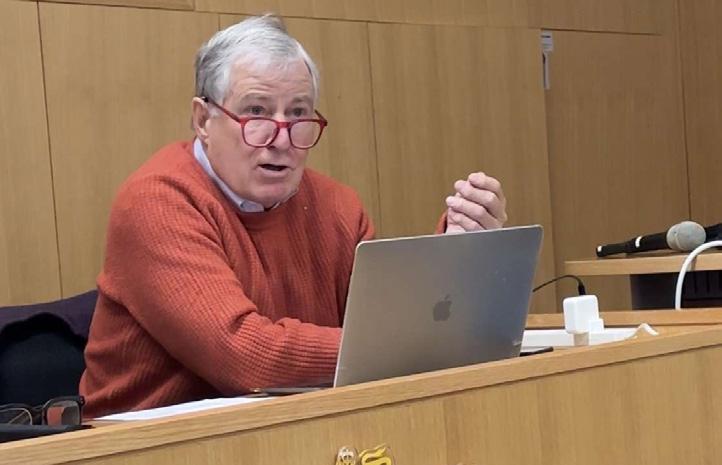
Bruce Houlder Chair of Panel 4 December 2024 Community Justice Hub Youth Justice : A Conversation
for criminal behaviour. It advocates for improved support systems and mental health resources for young people to address these challenges effectively. By fostering a better understanding of mental health, communities can work towards reducing youth crime and creating a more supportive environment for at-risk individuals.
[1] NHS England, ‘Mental Health of Children and Young People in England, 2023 - Wave 4 Follow up to the 2017 Survey’ (NHS Digital2023) https:// digital.nhs.uk/data-and-information/publications/ statistical/mental-health-of-children-and-youngpeople-in-england/2023-wave-4-follow-up
[2] Mental Health Foundation, ‘Children and Young People: Statistics’ (www.mentalhealth.org.uk2023) https://www.mentalhealth.org.uk/explore-mentalhealth/statistics/children-young-people-statistics
[3] Daniel, ‘Poverty Is Associated with Both Risk Avoidance and Risk Taking: An Empirical Test of the Desperation Threshold Model’ (SocArXiv9 February 2024) https://ideas.repec.org/p/osf/ socarx/gqjkm.html
[4] Lawrence Robinson and Melinda Smith, ‘Social Media and Mental Health: Social Media Addiction’ (HelpGuide.org21 August 2024 https://www.helpguide.org/ mental-health/wellbeing/social-media-and-mental-health
[5] Sophie King-Hill, ‘The Toxic Influence of Andrew Tate: How Society Has Failed a Generation of Young Men and Boys – Social Sciences Birmingham’ (blog. bham.ac.uk8 February 2023) https://blog.bham. ac.uk/socialsciencesbirmingham/2023/02/08/ andrew-tate/










Over the summer, outside of term time, Graphic Design students from Loughborough University were invited to take part in an elective project. They were invited to produce anti-knife crime campaign material to address the serious issue of knife crime and encourage positive societal change.
The project brief asked students to tailor their campaigns to an audience of their choosing, each with a specific angle on addressing knife crime. They could choose to focus on convincing government officials to enforce stricter knife control laws or to reallocate
funds to support community activities for young people in underprivileged areas. Students could target young individuals who might be vulnerable to the influence of knife crime or focus on informing parents of the risks that their children might face. Students could consider selecting a specific location (i.e. city) within the UK or the UK population as a whole.
Students were encouraged to use visual communication, through illustration, storytelling, photography and copywriting, to design campaigns that could resonate deeply with their chosen audience.
I am from Beeston and live close to where the Nottingham attacks took place on 13th June 2023. Whilst any death is a tragedy it seemed to resonate more deeply when an attack takes place close to home. The more I heard about Grace O’Malley-Kumar, Barnaby Webber and Ian Coates the more they sounded like such wonderful and kind individuals.
My teaching day at Loughborough University involves getting in early –speaking to the cleaner or caretaker before teaching bright young people (a similar age to Barnaby and Grace) all day.
Since the attacks took place, I have been more receptive to the grief (and dignity in grief) of so many people who have lost loved ones to knife crime as well as the increasing frequency that such violent crimes occur.
Over the past year I learnt more about the lives of individuals and victims of knife crime including Harry Pitman (16), Jermaine Cools (14), Ava White (12), Ben Kinsella (16) and Shawn Seesahai (19), to name just a few, as well as their families.
Saying sorry for your loss did not feel like enough.
I see how talented, bright and empathetic our students are. The project was organised as an optional pro-bono brief. It felt like a way that we could honour the memories of all of those who had lost their lives to knife crime.
When researching more to inform the project briefing presentation I learnt:
‘Nearly half of homicide victims killed with a gun or a knife are aged 15 to 24 despite the age group accounting for only 12% of the population’ (Office for National Statistics. Figures released in the week commencing 22nd April 2024)
And that ‘teenagers in the UK today are twice as likely to be fatally stabbed
as they were ten years ago’ (Sergeant, H., 27th April 2024).
The urgency of the issue is further reflected by the Office of National Statistics who have said that ‘knife crime is rising at its fastest rate for five years’ (2024), which is extremely concerning.
As so many of the victims are a similar age to that of the students I teach, I wanted to see how they would respond to the brief and what they thought could be done.
Throughout this edition of the magazine there are numerous pieces of the students work, which were produced in response to the project brief.
The exact brief asked them to consider a graphic design response to a specific issue directly linked with knife crime and stabbings.
Dan Hatfield’s campaign approached knife crime from the angle of health preservation by seeking to address the fact that too many young people are dying or are unprepared/uneducated in treating the stab wounds of their friends and family. Dan’s project called #PatchTheSlash aims to both save young adult lives, in addition to providing a second chance to break the cycle of knife crime to those that have faced death. Dan conducted extensive research to inform his project outcome from onscene first-aid and stab wound treatment from; The NHS, St John Ambulance, British Red Cross, First Aid for Life and Onlinefirstaid.com.





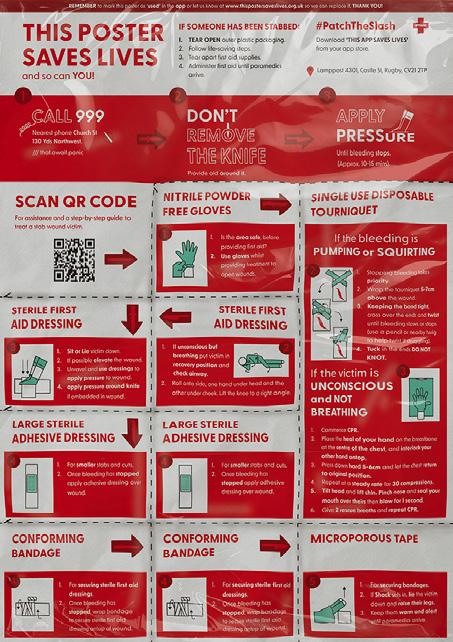






Georgia Smith 1, an Innovation Award winner, who reviewed the project said “Dan’s #PatchTheSlash campaign was…such a brilliant and well executed concept that was backed by thorough research, where he’s taken time to understand the problem and how as a society we could work towards reducing the number of mortalities from knife crime.”
Dan’s feeling about knife crime and what needs to be done are that:
“Knife crime is so much more than violence. It’s about acknowledging fear, heartbreak and anger. The life-ending choice of carrying a knife is made by a vulnerable heart, so our ideas need to heal the heart and not punish it further. Hope and second chances are incredibly powerful, and I think we would be surprised of the knife free future we can create when we hope together.”
Since producing work for the project Dan has decided to support The Ben Kinsella Trust further. Ben was a promising graphic design student before he was killed at the age of 16. Ben never got the chance to fulfil his dream of becoming a graphic designer.
Niall Corcoran chose to target his project on young people within the West Midlands where he is from. Niall commented on the project “Having experienced the impact of knife crime first-hand in my youth, I became all too aware of the dangers many young people faced. My project ‘Think Life Not Knife’ was a chance to confront past traumas, channel my skills into meaningful social change and encourage young people to choose life over violence.” Niall wanted to remind us through his work ‘of our potential to build safer communities and
challenge the normalisation of violence among young people”.
Niall produced a wide range of campaign material and touch points for his project. He produced work to be shown for school presentations as well as posters and work for use in digital formats.

Elena Inch through her research felt that “a lack of opportunity and poverty are key causes for young people turning to knife crime.” In order to counteract this, she proposed a “campaign to provide young people in at-risk areas to learn and acquire skills that will help set them up for employment and feel part of a community” which she called “Skills not Kills”. Students, as part of their project, were asked to produce a ‘pitch document’ and/or a ‘project explainer.’ In Elena’s pitch document the reviewers saw a stakeholder map which she had produced. Elena, as part of her campaign, had produced campaign posters, social media digital assets, apparel and merchandise as well as other touchpoints.
The main targeted areas for Elena’s campaign would be urban communities and counties with the highest offence rates – such as the West Midlands, Cleveland, London, South Yorkshire, Greater Manchester, West Yorkshire, Merseyside, Essex, Humberside, and Leicester. (Allen, Carthew, Zayed, 2023, p13). Her campaign ‘Skills Not Kills’ would offer classes and workshops in trades such as cooking, electrician work, hairdressing, gardening, nail art,










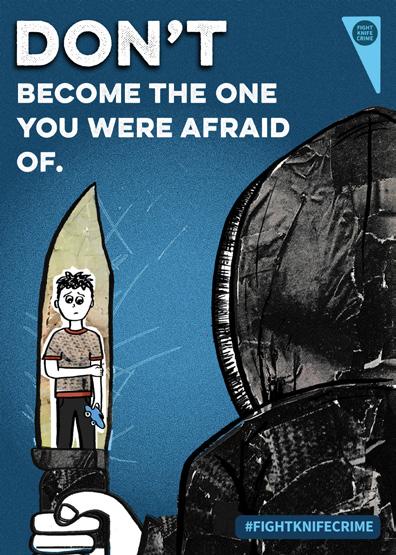

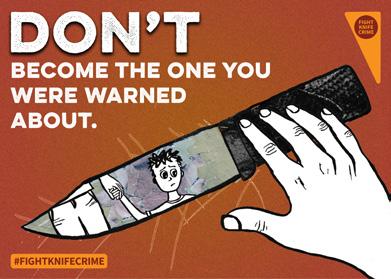






YOU ARE MORE THAN A STATISTIC

CHOOSE LIFE, NOT THE KNIFE

YOU WRITE YOUR OWN FUTURE
bricklaying, and more. Local businesses could support the campaign by offering work experience or apprenticeships to students.
Elena says this of knife crime and her work:
"I read stories about a Knife Crime related incidents in the local news almost every week. One of the key causes of it is often poverty or a lack of action by the government. When I heard about this (project)…, and the potential impact it could have, I wanted to create a campaign that would target this. Without organisations to provide vulnerable youth with skills for their future, there will be no change in the situation."
Similarly, Millie Fennell’s campaign work was fuelled by her feelings about knife crime and what needs be done:
“Knife crime is truly on the up and it's scary for everyone, but especially for young teenagers who are the most effected. I believe we need more funding put into youth clubs where people can become part of a community and turn to it as their safe space, which unfortunately many don't have.”
Joseph Smith chose to explore visual metaphors within his work. He used the idea of the knife as almost as a ticking clock which had a domino effect to suggest the actions of a perpetrator affect so many individuals. Joseph produced a piece of motion design which with the addition of sound was incredibly impactful and memorable. Joseph’s piece of motion design was accompanied by a poster.
Maya Norman chose to explore illustration and copywriting in her visual responses to the brief, which included posters, digital media assets and even
beer mats. Maya chose to focus on “the most common age to start carrying a knife”: 14 – 17 year olds according to the North West Community Services.
Maya wanted the visual outcomes for this campaign to “provoke an emotional response in viewers that may be susceptible to committing knife crime. This should encourage them to stop and reflect on their actions. The outcomes should influence the viewer to think about the child inside of them - a younger version of themselvesand the impression it would leave if they knew their future self would be involved in knife crime. The viewer should know their younger self would be afraid, disappointed and shocked at themselves, and this realisation should push the viewer to take responsibility for their actions. It also encourages people to think about the role model they are being for their younger siblings, cousins or friends, and whether this is the behaviour they want to be known for. This emotional response should persuade the viewer to put their ‘Knives Down’, step back from a situation, and prevent further knife crime.”
Maya’s thoughts on knife crime and what needs to be done are as follows:
"Knife crime is prominent amongst young people and is becoming increasingly more common. This violent behaviour destroys families and friendships and therefore anti-knife crime campaigns are essential to prevent violence and deaths. I believe education about the risks and consequences of knife crime is key to reducing the number of young people carrying knives."
The visuals the students produce, if used within a real-life scenario, would
emphasise the urgency of the issue.
Palak Bothra has a keen interest in advertising. In her campaign Palak thoughtfully used photography and the use of reflections to further elicit a response from her viewer.
Palak through her research found that ‘carrying a knife not only makes you 3 times more likely to get stabbed’ but saw it t hat also destroys dreams, hopes, and aspirations of the victims, perpetrators and all of their families. She chose to utilise wo rds within her campaign to make reference to this especially.
One of Palak’s posters was “strategically placed at a bus stop, offering the target audience a chance for direct interaction. Made with a reflective surface that mimics a mirror, the poster allows the audience to see their reflection—encouraging them to literally and figuratively reflect on the potential consequences of carrying a knife. This immersive experience fosters a deeper emotional connection.”
Palak’s other poster “uses the same design elements but replaces the plain background with a picture of a person, making the message more personal and relatable to the target audience. By including a human face, the poster aims to evoke empathy and draw attention to the real-life impact of knife crime, making it feel more immediate and relevant to young people. This design also allows for the advert to be converted into posters and flyers, making it easy to distribute in schools and at anti-knife crime events.”
Palak has said:
"Knife crime doesn’t just harm the victim; it destroys the life of the pe rpetrator too. A single decision can
lead to years of regret, lost opportunities, and the weight of knowing you’ve caused irreversible pain. Educating young people about this reality is vital to breaking the cycle of violence."
Andreas Au also used visual metaphors within her two visual outcomes, “with the aim to deter potential perpetrators from committing knife crimes through an emotional response.” Andreas “decided to target teenagers with the campaign as they are most at risk. To connect with them, I decided to approach the brief with the concept of video games as violence in video games has negative influences on their behaviour.”
These are just a few examples of students work as well as their thoughts and feelings on the issue of knife crime and attacks.
I think that design is for impact. As people we are designed for impact. Our actions good or bad have significant impact (and influence) on those around us, which we can see so deeply with this issue.
Kaia Dendaluce 2 , a reviewer of the project work who works as a Designer at a Hundred Studios, said this:
“Design is a practice of

communication. To do that well we need to speak the language of the people we are designing for.
By slowing down, listening to the people we are interacting with, and emphasising with their unique experiences, we can learn to speak their language and become better designers.”
Students who took part in the project were encouraged to be empathetic and sensitive to their target market.
Initially students attended a presentation briefing where they were introduced to different pieces of information to help support their studies and provide more information as an initial starting point for their project. Students were encouraged to conduct further second-hand research to gain insights of their own.
The project was supported by Nigel McCrery, former Murder Squad Detective and Writer of BBC’s Silent Witness. Nigel gave an online lecture to support students, sharing insights from his time as a Detective and Writer to underscore the gravity of the subject.
Interest in the project has also come from Jacob Dunne, a Community Ambassador for Nottingham’s Violence Reduction Unit who is heavily involved in restorative interventions to help young people to thrive.
The student work was reviewed by Loughborough alumni and industry professionals. These included Jess Shaw3 (a Design for Social Value Award Winner) currently working for Gymshark, Kaia Dendaluce (who won a Wood Pencil at the Design & Art Direction Awards) who works for Hundred Studios in Belfast and Georgia Smith (an Innovation


Award winner) now working for IBM.
Georgia Smith said:
“It was a pleasure to review work of such a high standard for such an important and sensitive topic. Even with such a variety of entries, many
were original, thought provoking, and well-considered.”
The Anti-Knife Campaign Project was also supported by Professor Emily Keightley, Associate Pro-Vice Chancellor for Vibrant and Inclusive Communities, and the School of Design and Creative Arts. The project aligns with Loughborough University’s commitment to foster socially responsible and impactful design.
Bruce Houlder CB KC, and the Lord-Lieutenant of Greater London, Sir Kenneth Olisa OBE have also been incredibly supportive of this project initiative.
There has been a large range of people who have been interested and helped with the project in one respect or another and I am extremely grateful to all of them.
Throughout semester 2 and providing I have the students consent, I am intending to write to organisations, individuals and charity organisations who may be interested in using the work that the students have produced.
The intention of the project was that the work could potentially be used in a real world setting to persuade and inform. I have always found that visual communication can be used as a memorable tool to elicit influence on an individual and their behaviour. It is designed for purpose and effective communication. That is the hope with the project.
Editors note: For additional design work on knife crime prevention from young student designers, do please click on the following links-
Niall Corcoran - https://niallcorcoran. co.uk/thinklifenotknife
Dan Hatfield - https://hatfielddesign.co/ patch-the-slash
Elena Inch - https://elenainchportfolio. myportfolio.com/skills-not-kills
References
[1] https://www.georgiasmithdesign.com
[2] https://kaiadendaluce.wixsite.com/kdendaluce
[3] https://jsdesign-portfolio.squarespace.com

www.lboro.ac.uk
Helen Nowell teaches on the Graphic Design / Graphic Communication and Illustration Degree Courses at Loughborough University and is a Senior Fellow of the Higher Education Academy.


By Michael Railton, Senior Associate – Firearms, Knives and Weapons Lead, Online Safety Group (michael.railton@ofcom.org.uk) & Catherine Wharton, Online Safety Policy Principal – Weapons, Drugs, Human Trafficking, and unlawful Immigration, Online Safety Group (catherine.wharton@ofcom.org.uk)
The UK’s Online Safety Act 1 has an important role to play in tackling the scourge of knife crime. Ofcom is responsible for implementing and enforcing the Act and has set out several measures tech firms can take to address illegal activity on their platforms, including offences related to the sale and glamourisation of knives. For example, tech firms
will be required to assess the risk of illegal knife-related content being disseminated on their platforms and ensure they have robust governance measures in place to manage these risks.
Where there is a high risk of such content appearing on their platforms, they will need to resource and train their content moderation teams so
they are able to accurately identify such content and quickly take it down once they become aware of it.
Ofcom’s codes also state that when services are testing potential changes to their recommender algorithms, they should measure the impact the changes would have on the risk of knife-related content being disseminated. We have supplemented these provisions with detailed guidance on what types of kniferelated content are illegal and must be removed and how to recognise such content.
Where platforms don’t follow the new rules, Ofcom has robust powers to act, including the authority to impose fines of up to 10% of a company’s global revenue. Taken together, Ofcom hopes these measures will help bring about a culture shift in tech firms, towards a culture where they are proactively assessing and managing the risk of illegal content, including the risk of knife-related content circulating on their platforms.

Michael Railton Ofcom’s, Firearms, Knives & Weapons Lead added,
“While we think the steps we are taking so far will help combat knife-related content, we know more needs to be done. To this end, I am determined that everyone has a valued voice in shaping our regulative approach. We are working closely with law enforcement agencies, NGOs and others, to explore further – more tailored – steps we could push the platforms to take to combat the dissemination of kniferelated content online.”
Catherine Wharton, Illegal Harms Policy Principal stated,
“Our Supervision team will engage with the largest and highest-risk services to proactively address compliance concerns. As part of this engagement, we will be working to ensure that platforms’ bladed weapons policies comply with our guidance on what knife related content is illegal and should be removed.”
While the Online Safety Act has a key role to play in combatting the online sale and glamourisation of knives, it’s important to note that Ofcom’s role is to drive systemic change in online safety , rather than to manage individual complaints or remove specific content. Michael clarified that, “ Our powers will not extend to taking down videos, posts or accounts, though we will absolutely expect services to have the right systems in place to ensure illegal content is removed swiftly .”
Catherine concluded,
“Our commitment to combating knife crime online remains strong, and we believe that our work on the Online Safety Act will significantly contribute to this goal, particularly through our cross-cutting codes and the requirements of the Illegal Content Judgment Guidance, which will compel platforms to align their policies on bladed weapons with UK law.”
On the 16th of December 2024, Ofcom achieved a major milestone in implementing the Online Safety Act, with the publication of our first statement related to Illegal Harms.
Check out the link to read more: Statement: Protecting people from illegal harms online - Ofcom www.ofcom.org.uk/online-safety/illegaland-harmful-content/statement-protectingpeople-from-illegal-harms-online/
Call out point:
“Our greatest asset is our youth— both those who have experienced the challenges we aim to prevent and those currently facing them. I am committed to reaching and engaging with these individuals at every step of the way."
– Michael Railton
www.ofcom.org.uk
michael.railton@ofcom.org.uk
Catherine Wharton Online Safety Policy Principal –Weapons, Drugs, Human Trafficking, and unlawful Immigration Online Safety Group
catherine.wharton@ofcom.org.uk


Catherine Wharton Michael Railton Senior Associate – Firearms, Knives and Weapons Lead Online Safety Group

